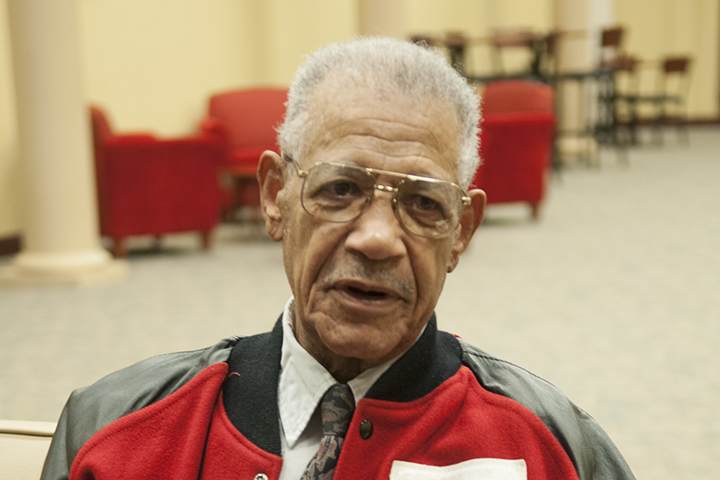The facts and figures recorded in the University’s archives about Old Main give a good sense of the building’s grandeur, but they can’t convey the emotion tied to such a significant campus landmark.
For that it takes personal experience and memories, such as those still cherished by Eugene A. Hunter.
Hunter holds the employee service record at Illinois State University, starting at 20 and changing his last fluorescent light at 72. He worked under nine presidents and knew the people several buildings are named for, including Arthur Watterson, Nelson Smith, Ruth Stroud, Pop Horton, Howard Hancock, Dean Schroeder, and Clyde Hudelson.
He met Carter Harris, the beloved building service worker who was employed at ISU for 48 years. Harris is honored to this day with a physical plant building that bears his name. Only 11 at the time they met, Hunter didn’t say anything to Harris but smiles at the thought of having broken his service record.
When Hunter started, a street ran through the Quad. Hovey Hall, Milner Library, and Hancock Stadium didn’t exist. Neither did the towering residence halls. “The campus you’re looking at now is the second campus,” he said.
Now 80, Hunter still has a vivid mental picture of Illinois State Normal University, and especially Old Main. He worked in the building and remembers it as his most difficult assignment. There were no elevators or air conditioning. At night he had to close all the windows on three floors, a task that took two hours.
Yet Hunter never gave a thought to working anyplace else, grateful for a job that paid well and offered security. He was particularly pleased to keep his strong campus ties, which go back to his youth.
Hunter attended Thomas Metcalf School and University High School when they were still housed in Moulton Hall on the Quad. He rode his bike home for lunch because the restaurants that ringed the campus wouldn’t serve him as an African-American student.
An athlete at U-High, he can still remember he ran the 100-yard dash in 10.3 seconds, and the name of the boy who ran faster. His dream was to run track and play football at Illinois State while studying industrial arts. The campus already felt like home as his father, Eugene F. Hunter, worked at ISU as a foreman for 29 years and until his death in 1971.
Eugene began his 52 years of service under President Raymond Fairchild, who hired him for second shift maintenance in 1950. There were only 1,500 students at that time. Hunter cleaned residence halls that African-Americans weren’t allowed to live in.
“It was rough, very segregated,” he said. “It hurt me, it hurt my family.”
But he was treated well on campus and loved his job, which was interrupted by a draft notice only four months into it. Fairchild promised Hunter if he returned safely from the Korean War, where he served in Ansbach, Germany, he’d have a job for life. Two years later Hunter was home, injured but healthy enough to work.
He swept floors and emptied trash in Smith Hall, which was filled with 52 men, many of them veterans. And he built relationships, including one with Dean of Men Ralph Linkins, who often asked Hunter for advice.
“I’d tell him to do what he thought he should, but do it in the right way,” said Hunter, who gained respect of the campus community throughout his years of service. He is remembered by former coworkers, students and faculty as loyal, private, quiet, steady, and able to get along with everyone.
Never married, Hunter cared deeply about the students. He chose to work in Manchester Hall for so long that he watched a second generation of students move in. He stayed because he thought he could make a difference to students, Rick Lewis said.
Now associate dean of students, Lewis met Hunter while serving as a residence hall coordinator in Manchester. He remembers and appreciates Hunter’s involvement in the lives of students.
“Gene taught them humility, grace, and what it meant to be a man. He taught students more about life than they learned in the classroom,” Lewis said. “For many of those students, their first encounter with an African-American was Gene. He worked on some of the toughest floors in Manchester but students kept them up because of their respect for Gene. He was the most popular guy on the floor.”
When Hunter reached 50 years of service, there was a celebration. President Vic Boschini presented him with an Illinois State letter jacket and a University High School class ring, which replaced the one that was stolen when his home was robbed.
He was honored with the Distinguished Service Award in 1981, which is the highest accolade given to staff. “It meant that I accomplished all the good deeds at ISU that I could,” Hunter said. “I thank ISU and the students and the faculty and my coworkers for that.”
Hunter retired in 2003 and now lives in Bloomington only a couple of blocks from where he grew up, along a brick street with modest homes that have wrought-iron railings, screen doors, and scattered gardens. He still goes to First Christian Church, where he started serving as a deacon when he was only 12. And he still enjoys visits to the campus that he has watched evolve as construction projects over time have changed the landscape.
Perhaps the biggest change was the loss of Old Main. A memorial marks where the building once proudly stood on the Quad. The bell also remains on the Quad and is rung on special occasions. Hunter was chosen as a bell ringer during a past Founders Day bell ceremony—a celebration with special meaning for the man who gladly served the University, including in the halls of Old Main.

